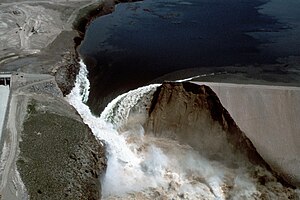
Back Разбурэнне дамбы Byelorussian Selhání přehrad Czech Dammbruch German Rotura de presa Spanish Rupture de barrage French Kebobolan bendungan ID Užtvankos griūtis Lithuanian അണക്കെട്ട് തകർച്ചകൾ Malayalam Barragem#Barragens fracassadas Portuguese การวิบัติของเขื่อน Thai


A dam failure or dam burst is a catastrophic type of structural failure characterized by the sudden, rapid, and uncontrolled release of impounded water or the likelihood of such an uncontrolled release.[1] Between the years 2000 and 2009 more than 200 notable dam failures happened worldwide.[2]
A dam is a barrier across flowing water that obstructs, that directs or slows down the flow, often creating a reservoir, lake or impoundments. Most dams have a section called a spillway or weir over or through which water flows, either intermittently or continuously, and some have hydroelectric power generation systems installed.
Dams are considered "installations containing dangerous forces" under international humanitarian law due to the massive impact of a possible destruction on the civilian population and the environment. Dam failures are comparatively rare, but can cause immense damage and loss of life when they occur. In 1975 the failure of the Banqiao Reservoir Dam and other dams in Henan Province, China caused more casualties than any other dam failure in history. The disaster killed an estimated 171,000 people[3] and 11 million people lost their homes.
- ^ Souza, Leonardo; Sanjay Pandit, Grishma; Prakash Chanekar, Tanvi. "Case Study and Forensic Investigation of Failure of Dam Above Kedarnath" (PDF). International Society for Soil Mechanics and Geotechnical Engineering. Archived (PDF) from the original on 29 January 2019. Retrieved 28 January 2019.
- ^ "Science Engineering & Sustainability: Dam break simulation with HEC-RAS: Chepete proposed dam". Science Engineering & Sustainability. Archived from the original on 2020-06-12. Retrieved 2019-12-07.
- ^ Osnos, Evan (October 12, 2011). "Faust, China, and Nuclear Power". The New Yorker. Archived from the original on March 13, 2016.
© MMXXIII Rich X Search. We shall prevail. All rights reserved. Rich X Search